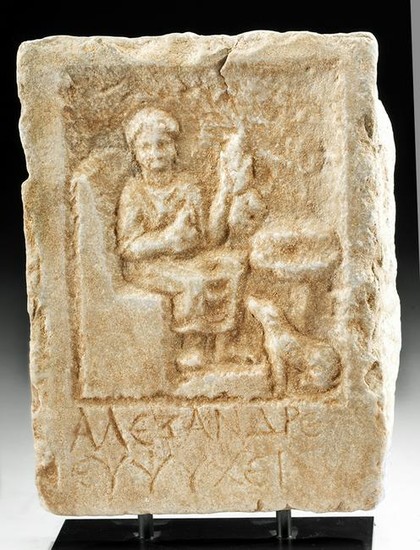Greek Marble Stele w/ Epitaph to Alexander & Dog
Ancient Greece, ca. 4th to 2nd century BCE. Finely carved in bas relief, a marble funerary stele depicting a seated figure draped in a long garment, holding an object or possibly an infant, with a loyal hunting dog. The epitaph inscribed below reads, "????a?d?e e????e? " which translates, "Alexander, farewell." The second section literally means, "be of good courage" but is used idiomatically on funeral stelai. It is possible that the imagery portrays the deceased holding tools of his trade or hobby; however, another possibility is that this is Alexander's mother holding an infant Alexander. Family connections were of the utmost importance in ancent Greece, and the imagery of funerary monuments oftentimes demonstrated family unity even after death. A carved relief stele such as this one was part of a long tradition of marking the graves of elite and even some middle class Greek citizens. Size: 7.375" W x 9.625" H (18.7 cm x 24.4 cm); 10.75" H (27.3 cm) on included custom stand.
The dog depicted on this stele is lean with a body built for speed. He is most likely a Laconian hound, the swift, Spartan dog known to be native to ancient Greece, used for hunting, guarding the home and livestock, and of course canine companionship. Xenophon, born around 430 BCE, describes the Laconian hound in his work about hunting with dogs, the Cynegeticus: it should be large, with a small head, straight nose, upright ears, a long and supple neck. The eyes should be black and sparkling, and it should be tan and black or black and tan. He wrote that, when hunting, they should, "give chase vigorously without relaxing, with much clamor and baying, all coming out together after the hare on every side. Let them pursue fast and brilliantly, borne along after her in a pack, giving tongue properly again and again."
See a funerary stele dedicated to Stephanos that also includes the deceased's dog (NAMA2578) in the National Archaeological Museum of Athens.
Provenance: private J.H. collection, Beaverton, Oregon, USA, acquired in 2016; ex-Galerie-Puhze, Freiburg, Germany
All items legal to buy/sell under U.S. Statute covering cultural patrimony Code 2600, CHAPTER 14, and are guaranteed to be as described or your money back.
A Certificate of Authenticity will accompany all winning bids.
We ship worldwide to most countries and handle all shipping in-house for your convenience.
#150045
Condition Report: A small section reattached to upper center with minor loss at breakline. Expected chips to peripheries and wear to high-pointed areas. Earthen and mineral deposits.
View it on
Sale price
Estimate
Time, Location
Auction House
Ancient Greece, ca. 4th to 2nd century BCE. Finely carved in bas relief, a marble funerary stele depicting a seated figure draped in a long garment, holding an object or possibly an infant, with a loyal hunting dog. The epitaph inscribed below reads, "????a?d?e e????e? " which translates, "Alexander, farewell." The second section literally means, "be of good courage" but is used idiomatically on funeral stelai. It is possible that the imagery portrays the deceased holding tools of his trade or hobby; however, another possibility is that this is Alexander's mother holding an infant Alexander. Family connections were of the utmost importance in ancent Greece, and the imagery of funerary monuments oftentimes demonstrated family unity even after death. A carved relief stele such as this one was part of a long tradition of marking the graves of elite and even some middle class Greek citizens. Size: 7.375" W x 9.625" H (18.7 cm x 24.4 cm); 10.75" H (27.3 cm) on included custom stand.
The dog depicted on this stele is lean with a body built for speed. He is most likely a Laconian hound, the swift, Spartan dog known to be native to ancient Greece, used for hunting, guarding the home and livestock, and of course canine companionship. Xenophon, born around 430 BCE, describes the Laconian hound in his work about hunting with dogs, the Cynegeticus: it should be large, with a small head, straight nose, upright ears, a long and supple neck. The eyes should be black and sparkling, and it should be tan and black or black and tan. He wrote that, when hunting, they should, "give chase vigorously without relaxing, with much clamor and baying, all coming out together after the hare on every side. Let them pursue fast and brilliantly, borne along after her in a pack, giving tongue properly again and again."
See a funerary stele dedicated to Stephanos that also includes the deceased's dog (NAMA2578) in the National Archaeological Museum of Athens.
Provenance: private J.H. collection, Beaverton, Oregon, USA, acquired in 2016; ex-Galerie-Puhze, Freiburg, Germany
All items legal to buy/sell under U.S. Statute covering cultural patrimony Code 2600, CHAPTER 14, and are guaranteed to be as described or your money back.
A Certificate of Authenticity will accompany all winning bids.
We ship worldwide to most countries and handle all shipping in-house for your convenience.
#150045
Condition Report: A small section reattached to upper center with minor loss at breakline. Expected chips to peripheries and wear to high-pointed areas. Earthen and mineral deposits.



